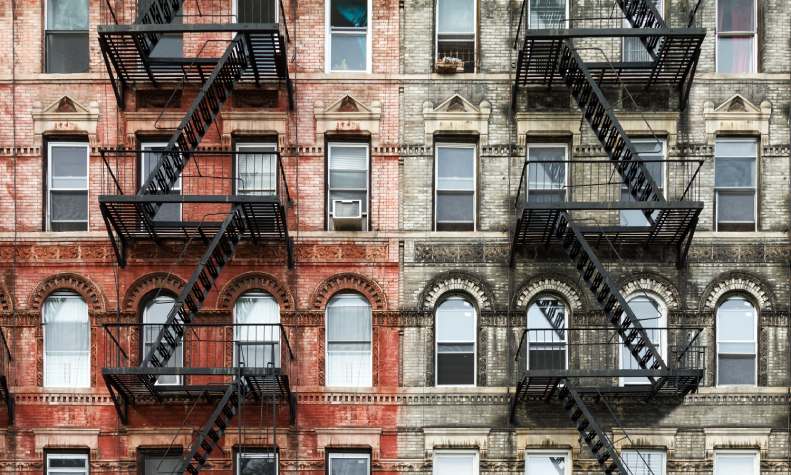
In an era marked by evolving technology and growing urban landscapes, the need for comprehensive building inspections and modern monitoring systems has never been more critical
In recent years, the United States has experienced a series of structural failures in concrete structures. From collapsed bridges to compromised buildings, these incidents underscore the critical need to address structural vulnerabilities for the safety of both assets and lives. Our last blog post, “Ensuring Long-Term Safety and Operation of Bridges Over the Years,” reflects on the current state and performance of the nation’s vital infrastructure system. Although this report primarily addresses public infrastructure, these structural challenges are not immune to private-owned structures such as residential condos, mixed-use buildings, and parking garages.
Continuing I-TEK’s advocacy efforts for emphasizing the crucial need to safeguard the integrity of our built environment, this blog delves into the common causes of structural failures, explores casualty data, examines the 2021 national infrastructure report, and discusses the risks faced by private-owned structures. Furthermore, we’ll highlight the nation’s efforts to protect assets and lives, the legal framework in place, and preventive strategies crucial for fostering a safer built environment.
Most Common Causes of Concrete Structural Failures:
Concrete, often considered the backbone of our built environment, is one of the world’s most widely used building materials thanks to its strength, durability, and versatility; however, it is not immune to failures that can have severe consequences, including fatalities. Structural failures often find their roots in one of the following causes: material deficiencies, design flaws, construction issues, and the challenges posed by aging infrastructure.
This means that a structure is susceptible to different types of failures throughout its entire service life, spanning from the design phase through construction and eventual occupancy and maintenance. This blog post will focus on the most common causes of concrete failure due to poor maintenance and how preventative monitoring can come into play for engineering and state-mandated inspections.
First, let’s begin by mentioning that reinforced concrete is the most common type of concrete used in modern construction and is generally engineered for a lifespan of 50 to 100 years if properly maintained. Building codes and policies generally require buildings to survive for several decades, but deterioration can begin in as little as 10 years. Historically, concrete has been considered very forgiving regarding the time the material performs in service; however, the use of steel reinforcement (rebar) has impacted the durability of concrete structures in ways that are difficult to detect and costly to repair (Structure Magazine).
The list of potential causes of concrete failures is a long one. No building, including those constructed with reinforced concrete, can endure indefinitely. Over time, all structures will undergo wear and tear and will require maintenance, repairs, and potentially replacement. Despite its strength and durability, reinforced concrete remains susceptible to natural forces such as erosion, corrosion, and weathering. Additionally, environmental changes and shifts in building usage can stress the structure, prompting the need for repairs or renovations.
Perhaps the greatest threat to the long-term durability of reinforced concrete is corrosion of the steel with associated cracking and spalling of the concrete cover (Concrete Construction). Some argue that “Corrosion is a silent killer of buildings,” leading to billions of dollars in damage each year and structural degradation in terms of safety, stability, and aesthetics (Science Direct).
Corrosion is a natural process that occurs when metal reacts with its environment, making it nearly impossible to avoid entirely; however, proactive prevention measures can be taken. Exposure to chloride ions and carbonation stands out as the primary culprits for rebar corrosion, potentially leading to severe structural damage and even collapse. It causes reduction in cross-sectional area of reinforcement, deterioration of mechanical properties, and degradation of bonding properties between reinforced concrete, which are the most important factors leading to the degradation of structural service performance. (Concrete Construction)
The Aging Foundations in the US
As the years pass, the median age of housing stock in the country continues to rise, posing a potential threat to structural safety. For instance, in New York City, which had two prominent buildings collapsed in 2023, the median residential building is almost 90 years old.
According to the US Census in 2021, the median age of housing stock in the US has been steadily increasing. Many residential buildings, particularly in older neighborhoods and urban areas, have surpassed their initial design life. As stated by the latest data from the Department of Housing and Urban Development American Housing Survey (AHS), the median age of an owner-occupied home in the United States was 45 years old, but what is more alarming is that 37% of all structures were built prior to 1959, meaning 55 years of built or older.
Distribution %- Median Age of Housing in the US
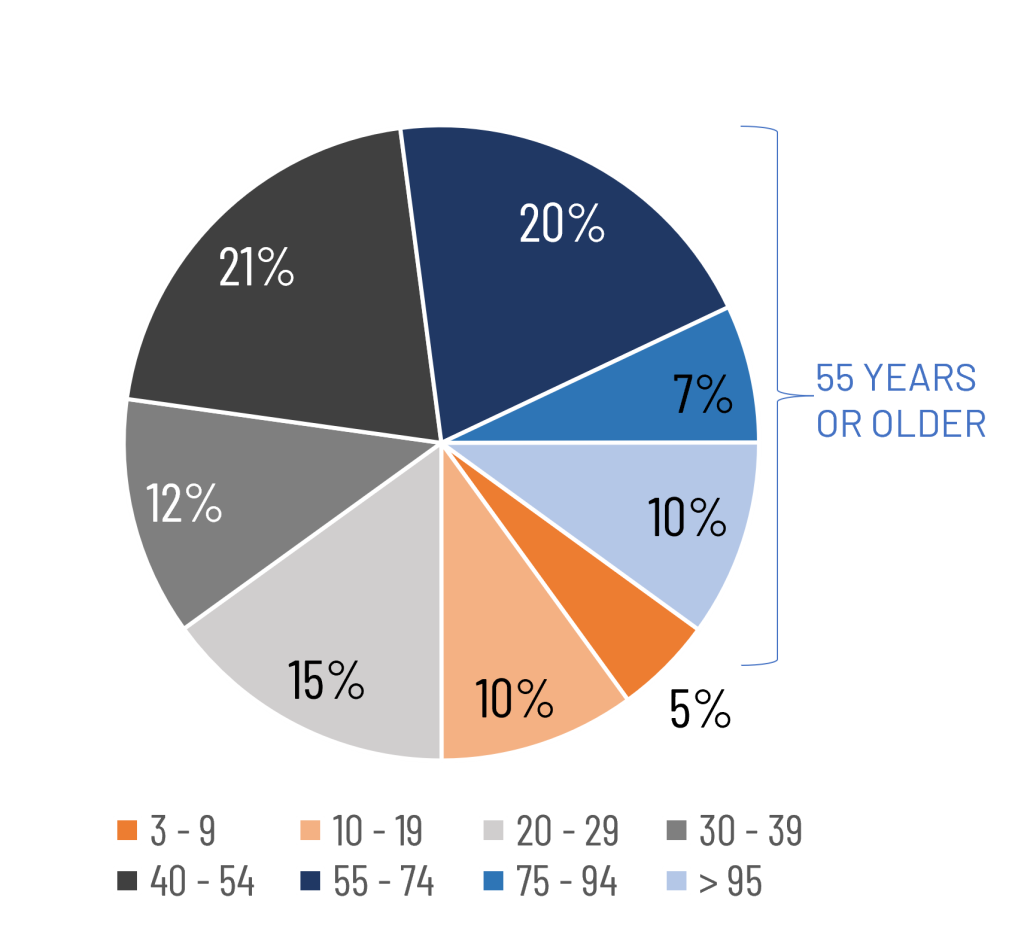
The implications of this aging process extend beyond mere aesthetics, reaching into the very core of structural integrity. As buildings age, the risk of structural failure becomes a growing concern, especially in higher densely populated cities
Median Age of Housing Stock – US Census Regions
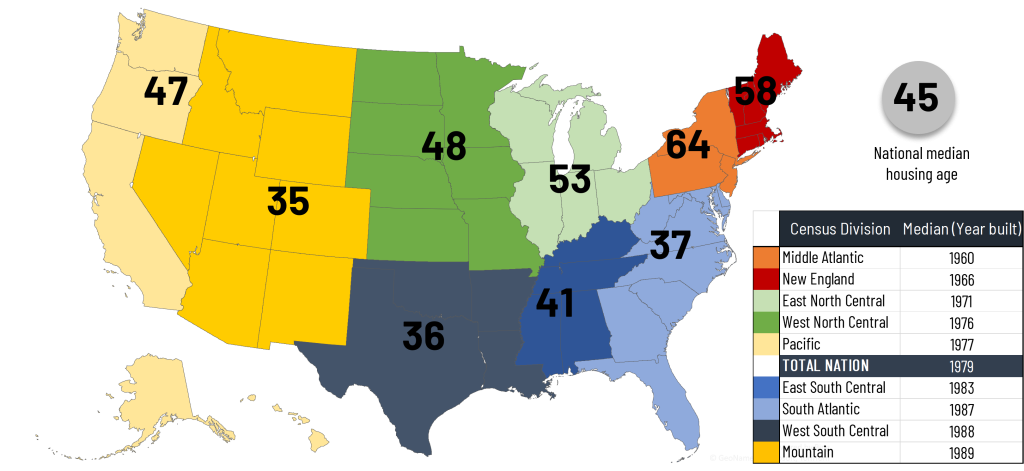
Top 10 Metropolitan Areas median age of housing stock
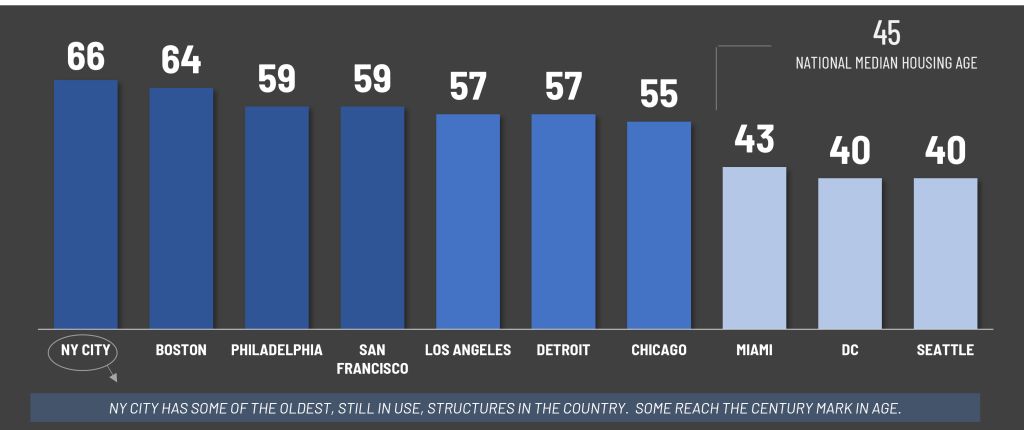
Because structural failures go beyond age, neglecting maintenance can lead to a cascade of structural problems, regardless of a building’s age. Inadequate upkeep accelerates wear and tear, compromises load-bearing elements, and weakens the overall integrity of a structure. The repercussions of such neglect may not manifest immediately but can result in catastrophic events over time, posing a threat to occupants and surrounding communities.
National Measures to Prevent Structural Failures and Collapses
Governments at both federal and state levels across the United States are taking proactive steps to address potential risks and ensure the structural integrity of infrastructures. At the federal level, there is a growing recognition of the need for comprehensive guidelines to prevent structural failures. The tragic collapses, such as the Miami condo disaster, have spurred discussions on creating national standards. Federal agencies are exploring ways to establish a robust framework that includes regular inspections, mandatory repairs, and adherence to modern safety codes. While there isn’t a nationwide mandate for comprehensive building inspections, the American Society of Civil Engineers (ASCE) recommends inspection protocols. Some states, such as Florida with Senate Bill 4D and New York City with Local Law 11 (Façade Inspection Safety Program – FISP), have initiated measures to protect structural and life integrity. However, these practices have not been universally adopted across the nation.
The Florida Senate Bill 4D establishes a statewide stricter structural inspection program, requiring Condominium and Cooperative buildings three stories or higher to conduct Milestone Structural Inspections of their buildings and to perform Structural Integrity Reserve Studies in order to ensure that Condominium and Cooperative buildings are safe for continued use.
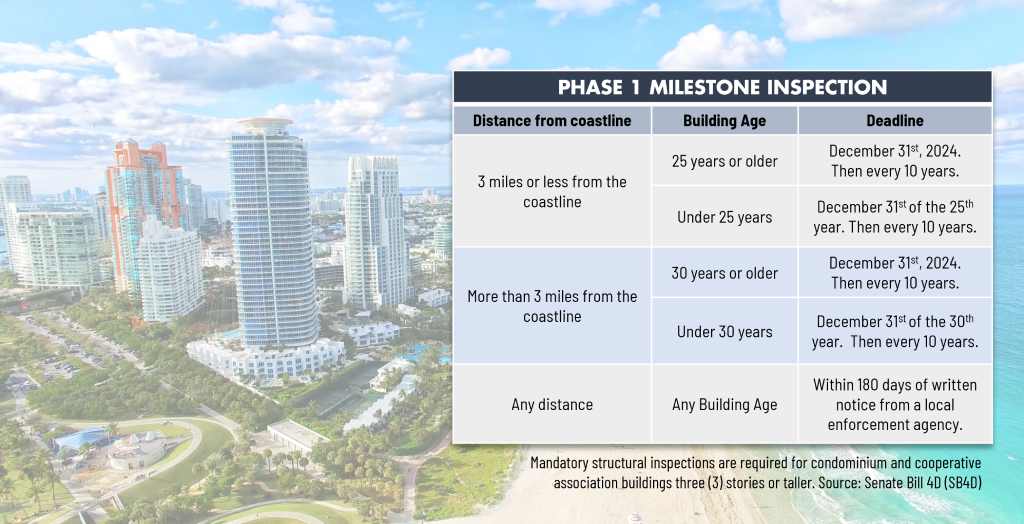
Building a Culture of Safety:
According to the Foundation for Community Association Research, there are 74.2 million Americans (29%) living in approximately 358,000 community associations in the US, but only 12 states require reserve studies for condominium associations: California, Colorado, Delaware, Florida, Hawaii, Maryland, Nevada, Oregon, Tennessee, Utah, Virginia, and Washington State. Among these, Florida stands out as the sole state that not only requires reserve studies but also mandates condominium and cooperative associations to complete a Structural Integrity Reserve Study (SIRS), a newly developed form of reserve study, every 10 years (Florida Senate Bill 4D).
The aging median age of housing stock in the United States raises pertinent questions about the structural safety of our built environment. Acknowledging the challenges and implementing proactive measures to address them is crucial for ensuring the resilience and safety of homes across the nation.
According to a recent Stanford University report titled “Guidelines for Life Cycle Cost Analysis,” as a building ages, the cumulative cost of operating and maintaining facilities significantly impacts the overall budget, not just the maintenance budget. The greater issue with deferred maintenance is that it only grows in scope—and cost— the longer it is deferred, resulting in 30 times the cost to repair versus keeping up with routine maintenance.
Therefore, beyond specific laws and regulations, there is a need to broaden efforts to foster a culture of safety within the construction and real estate industries. This includes promoting awareness about the importance of routine inspections, encouraging timely repairs, and educating stakeholders on the latest safety standards. Building owners, developers, and local authorities play vital roles in upholding these principles.
As we move forward in the pursuit of safer and more resilient structures, the adoption of modern safety standards will play a pivotal role. InfrastructureTek’s commitment to advancing technologies like our Corrosion and Humidity CORRODEC®2G sensors for concrete monitoring exemplifies a proactive approach to structural maintenance. Whether it’s a bridge, a commercial building, or a residential complex, our NB-IoT technology adds an extra layer of protection by identifying potential threats before they escalate.
The incidents of collapsed structures and compromised buildings serve as urgent reminders that the pursuit of structural integrity is not only a matter of preserving assets but, more crucially, safeguarding human lives. At I-TEK, we stand by our ultimate goal of value preservation, safety, and sustainability through NB-IoT early damage detection.
References:
- American Housing Survey (AHS). (2021). United States Census Bureau.
- Condominium Safety Public Policy Report. (2023). Community Associations Institute©
- Building Inspection & Structural Integrity. Community Associations Institute©
- Shaping the Future of Construction a Breakthrough in Mindset and Technology. (2016). World Economic Forum.
- Durability of Reinforced Concrete. (2016). Structure Magazine
- Why does steel in concrete corrode? (2014). Concrete Construction.
- Durability, service life prediction, and modeling for reinforced concrete structures – review and
- critique. (2019). Science Direct.
- Progressive Collapse Resistance Mechanism of RC Frame Structure Considering Reinforcement
- Corrosion. (2023). Hindawi.
- Corrosion of Reinforcement | Causes and Prevention. Structural Guide.
- Their home made headlines when it suddenly crumbled. Could it happen to you? (2023). USA Today.